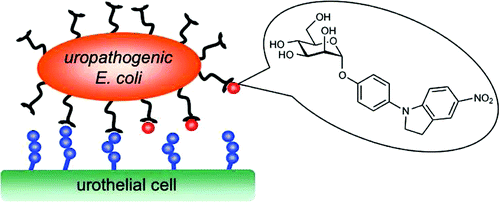A non-antibiotic approach for treating urinary tract infections

A potential new approach for treating urinary tract infections (UTIs) — which affect millions of people annually — without traditional antibiotics is being reported in ACS' Journal of Medicinal Chemistry. It involves so-called FimH antagonists, which are non-antibiotic compounds and would not contribute to the growing problem of antibiotic resistance bacteria.
Beat Ernst and colleagues explain that antibiotics are the mainstay treatment for UTIs. Bacteria, however, are developing resistance to common antibiotics, with the emergence of "superbugs" that shrug off some of the most powerful new antibiotics. Thus, the scientists decided to try a new approach — developing substances that target bacteria virulence factors, inhibiting them from sticking to the inside of the urinary bladder. Hence, microbes are not able to launch an infection and, furthermore, this new class of antimicrobials is expected to exhibit less selection pressure and, therefore, a reduced potential for the emergence of resistance.
The scientists describe the development of anti-adhesion molecules that specifically interfere with the attachment of bacteria to human bladder cells. The most potent of the substances, an indolinylphenyl mannoside, prevented a UTI from developing in mice (stand-ins for humans in this kind of experiment) for more than eight hours. In the in vivo treatment study, a very low dose of 25 µg per mouse reduced the amount of bacteria in the bladder of the animals by almost 10,000 times, which is comparable to the standard antibiotic treatment with ciprofloxacin.
More information: “Antiadhesion Therapy for Urinary Tract Infections — A Balanced PK/PD Profile Proved To Be Key for Success” J. Med. Chem., 2012, 55 (10), pp 4700–4713. DOI: 10.1021/jm300192x
Abstract
The initial step for the successful establishment of urinary tract infections (UTIs), predominantly caused by uropathogenic Escherichia coli, is the adhesion of bacteria to urothelial cells. This attachment is mediated by FimH, a mannose-binding adhesin, which is expressed on the bacterial surface. To date, UTIs are mainly treated with antibiotics, leading to the ubiquitous problem of increasing resistance against most of the currently available antimicrobials. Therefore, new treatment strategies are urgently needed, avoiding selection pressure and thereby implying a reduced risk of resistance. Here, we present a new class of highly active antimicrobials, targeting the virulence factor FimH. When the most potent representative, an indolinylphenyl mannoside, was administered in a mouse model at the low dosage of 1 mg/kg (corresponding to approximately 25 μg/mouse), the minimal therapeutic concentration to prevent UTI was maintained for more than 8 h. In a treatment study, the colony-forming units in the bladder could be reduced by almost 4 orders of magnitude, comparable to the standard antibiotic treatment with ciprofloxacin (8 mg/kg, sc).


















